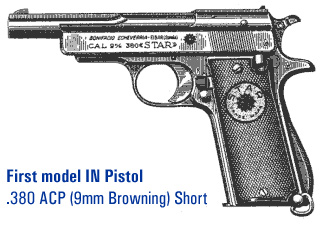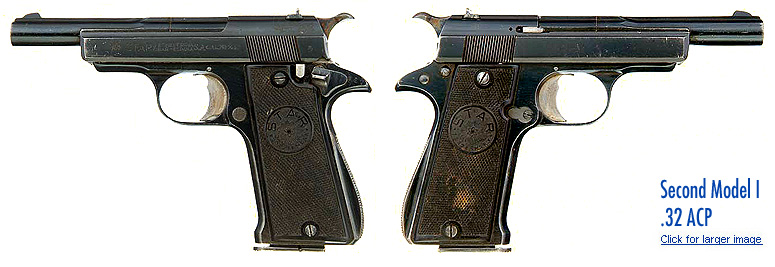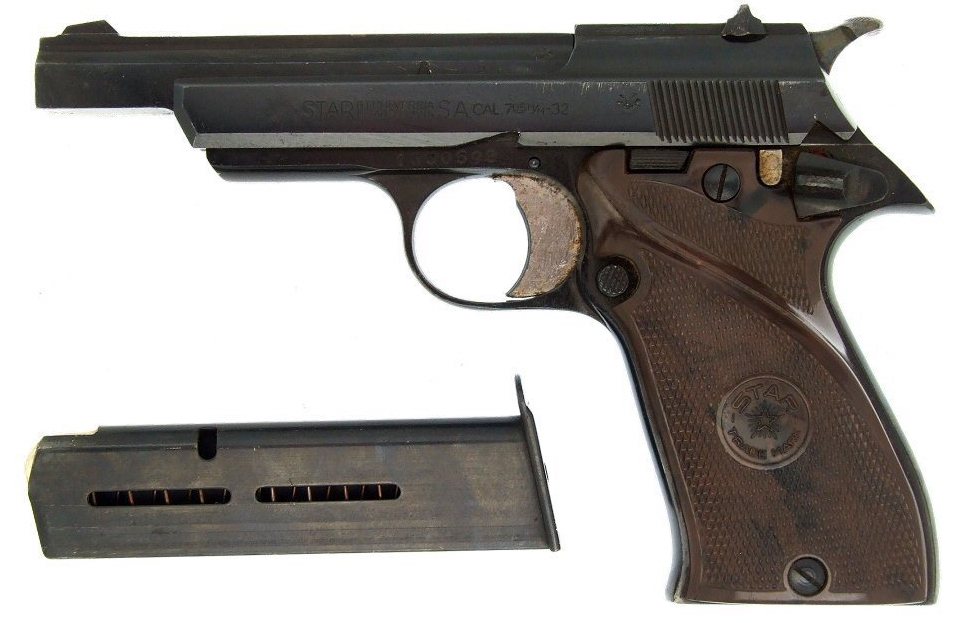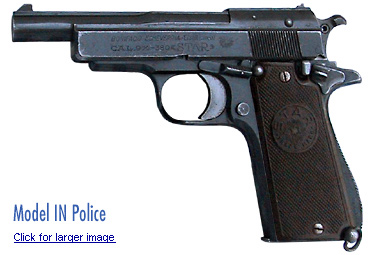Star Firearms — I-series pistols
The I series is a straight-blowback vest pocket pistol, mechanically designed along the lines of the model F. The I falls between the H and F series in total size.
The I appears to be a direct derivative of the F series .22 sport and target pistols, redesigned slightly to fire the .32 and .380 cartridges. There are several variants, generally following the improvements to the whole vest pocket pistol lines, with improvements over time to frame shape and safety lever being most notable.
Manuals & Disassembly Instructions
I do not have manuals for every pistol shown on this site. However, in many cases there is a related manual. Partly to make the series relationships clearer, and partly to assist with speed and accuracy of updating, all manuals can be found in one place, the manuals page. All manuals available are provided as downloadable PDFs, or you may purchase a printed copy of the entire set of handgun manuals.
All vest-pocket and target pistols operate and strip in approximately the same way. These manuals are very slim, and do not provide really useful step-by-step instructions. It may be beneficial to review all the manuals for this series to assure you have gotten all relevant information.
As some of these manuals are not in english, and have no diagrams, I will explain the basic takedown procedure here. Stripping is just like taking down most any straight-blowback, fixed barrel european gun (e.g. the Walther PPK). This is, however, somewhat unusual if you have only worked with larger Browning lock pistols in the past.
- As with any time you are working on a pistol, assure it is empty first.
- Remove the magazine and cycle the slide several times.
- Push down on the button at the top of the left grip panel, in front of the safety lever.
- While holding this button down, pull the slide to the rear approximately 1/2".
- In this position, the slide can now come up thru notches in the slide rails. Pull the rear of the slide up,/em. off the rails. Use caution, as the slide is still under full spring pressure.
- Lower the slide over and off the end of the barrel. Be careful not to scratch the barrel or other parts.
- Reassemble in the reverse manner.

First Model I & IN Pistols
The Model I pistols are broadly Model F pistols, with an increase in caliber to .32 ACP (7.65 mm). The frame and slide are of the same external dimensions, with additional metal removed from the inside to accomodate the larger caliber projectiles. This first generation model I pistol was produced from 1932 until 1935, when it was replaced with the second generations pistols described below.
The layout of the pistol is the same as the model F target pistols as well, with a protruding barrel and open slide with barrel visible over the whole length. They appear to all have been made with 4" barrels of the same profile.
These initial series pistols were typical of early pocket pistols, with no slide stop and a safety immediately above the magazine release, hinging under the left grip panel.
Early .380 Caliber Model I Pistols
The model I was also, throughout it's lifecycle, produced in .380 ACP (9mm Browning Short, 9 mm Corto) calibers. These are generally referred to as the model IN, where the N suffix refers to a .32 caliber model chambered in .380. However, there is some evidence a small number of .380 pistols produced in 1933 were of the model I designation. In 1934 and 1935 this switched to the model IN as it should have been all along.
Second Models I & IN Pistols
From 1935 to 1942 an improved model was made of the .32 caliber pistols, with the safety lever moved to the conventional "thumb" position, hinging about the top rear of the frame. Most Star pistols moved to this style in this timeframe, apparently to capitalize on the success of their larger pistols and that of the well-known Colt-Browning pistols from which they took their design cues. There is also a slide lock lever on the left side, of the general pattern of the full-size pistols.
In 1942, the slide lock lever was removed, and the frame modified to include a swell at the bottom of the grip, presumably in a nod to ergonomics and keeping fingers away from the magazine during insertion. Again, this is a feature seen in many other pistols, including the 1942 model F series. This may indicate the frames were forged and machined together for much of their production. This pistol remained in production until 1957, when replaced with the third model pistols (the F changed over the next year.

Model IN Police Pistols
The .380 caliber model IN appears to have only been made for a contract as the model "IN Police." I have no information on the numbers or which agency used the pistol. This is of the basic second model style, with the slide stop. Production ended in 1940.
Third Model I Pistols
Beginning in 1957, a third model of I pistols was produced, with notable changes to the style. The barrel was squared to appear more an integral component of the frame, and generally appeal to current style. Controls remained similar, as did the overall size and other characteristics. See the model F for representative detail changes with this generation.
A variant or changeover third/fourth model supposedly was made in 1967-only of this pistol with a slide stop as well but otherwise third-model features. Production of all third model pistols ended in 1967.

Fourth Model, the IR Pistols
As before, in parallel with Model F developments, the I series got updated with a similarly square profile barrel to the third model, but adds a slide stop, ergonomic thumb-rest grip panels, a pronounced rake to the front of the slide, and other styling and mechanical changes.
There were two barrel lengths, a near-flush one making it much more suitable as a pocket pistol, and the original length that protrudes noticeably. There is no apparent model number change to indicate the two lengths.
These were apparently only produced in .32 caliber, and all apparently marked "7.65 m/m .32" to cover their bases for what the cartridge is called in all markets. Production ended in 1983.
